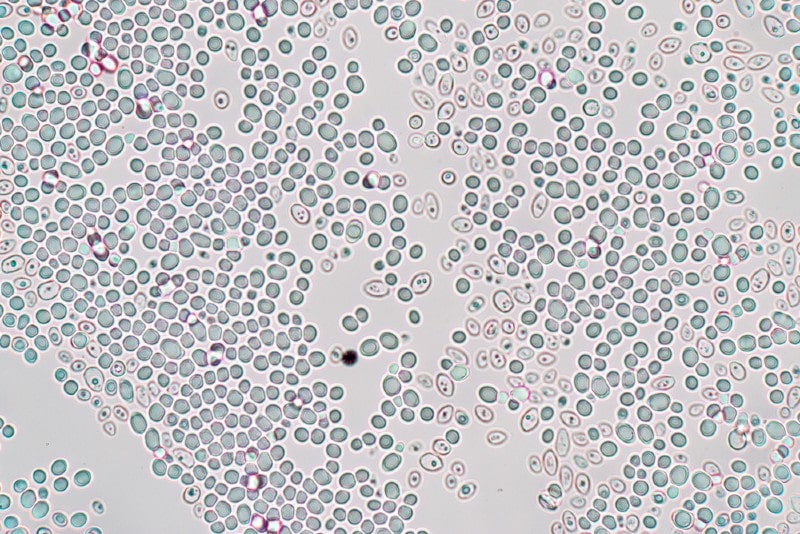What Does Yeast Look Like Under a Microscope? (With Pictures!)
Last Updated on

It’s easy to take yeast for granted. After all, it’s a ubiquitous part of our world. It gives us bread, baked goods, wine, and beer. It’s also vital in the environment in its ecology and as a potential means for removing pollutants through remediation. Humans have used yeast for thousands of years, with evidence suggesting ancient Egyptians understood its unique properties.1
To know what it looks like under a microscope, it’s helpful to understand what yeast is.2 After all, it is a living organism in many of its forms. Suffice to say that it’s a fascinating creature and incredibly valuable to people. You may think of it differently when we examine it more closely.

Yeast as an Organism
The word “yeast” describes a group of organisms that are part of the fungus kingdom, which also includes mushrooms and molds. They are eukaryotes like us, meaning the nuclei within their cells are enclosed in a membrane. They are single-celled organisms that may have evolved to give rise to multicellular life. Interestingly, yeast was the first of its type to have its genome sequenced.

Viewing Yeast Under a Microscope
We can thank Louis Pasteur and his discovery of fermentation for putting the spotlight on yeast to harness its various uses. If you’ve opened a packet of yeast, you’ll notice that it’s visible under the naked eye. However, to understand more about this organism, you’ll need to view it under a microscope.
You’ll find it easier to see if you mix the yeast with some warm water. Place a drop on a clean, blank slide and put a cover slip over it. You’ll be able to view it at only 400x magnification. However, a higher power will bring more detail into focus. The yeast will appear as symmetrical round shapes unless it is budding, its means of asexual reproduction. Some species are more elongated.
You can use a dye such as methylene blue to make it easier to see the yeast. You can distinguish it from other organisms by its shape and size. Bacteria are typically smaller, and debris will have irregular forms. You may notice a darker outline on the yeast cells, mainly if you’ve used a dye.
Types of Yeast
Yeast exists naturally in the environment on plants, fruits, and the soil. They are small organisms, ranging from 3–40 micrometers in some of the approximately 1,500 species. They are round or oval-shaped. The most common variety you’re likely to encounter is Saccharomyces cerevisiae, which is used for the edible products we mentioned earlier.
While many species are beneficial to humans, some are not, including Histoplasma spp. and Candida albicans. It’s worth noting that yeast also exists in gut and skin flora. These organisms use sugars and starches to produce carbon dioxide and alcohol. The earliest evidence of it used for the latter in winemaking goes back 8,000 years to the Republic of Georgia.
Cultured Yeasts
Humans have cultivated yeast for different purposes. For example, we have baker’s yeast for leavening bread and other dough-based foods. Winemakers have selectively cultured various types to bring out desirable qualities and aromatics in their beverages. They may use strain VL3 when making Sauvignon Blanc to bring out its characteristic exotic fruit aromas.
However, it isn’t just about making wine or beer. Yeast can also produce other types of alcohol, including ethanol, most commonly from corn.

Summing Up
Viewing yeast under a microscope reminds us that some of the most amazing organisms on the planet aren’t necessarily massive or complex. These simple single-celled creatures are living proof of it, especially when you consider how vital they are in so many areas of our lives. And thanks to the microscope and Pasteur, we can see them in a whole new light.
Featured Image Credit: Rattiya Thongdumhyu, Shutterstock
About the Author Chris Dinesen Rogers
Chris has been writing since 2009 on a variety of topics. Her motto with all of her writing is “science-based writing nurtured by education and critical thinking.” Chris specializes in science topics and has a special love for health and environmental topics, and animals of all shapes and sizes.
Related Articles:
How to Clean a Refractor Telescope: Step-by-Step Guide
How to Clean a Telescope Eyepiece: Step-by-Step Guide
How to Clean a Rifle Scope: 8 Expert Tips
Monocular vs Telescope: Differences Explained (With Pictures)
What Is a Monocular Used For? 8 Common Functions
How to Clean a Telescope Mirror: 8 Expert Tips
Brightfield vs Phase Contrast Microscopy: The Differences Explained
SkyCamHD Drone Review: Pros, Cons, FAQ, & Verdict
